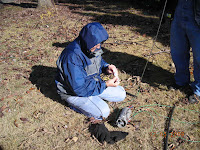ARRL Club Newsletter
December 18, 2009
_________________________________________________________
Norm Fusaro, W3IZ, Editor
IN THIS ISSUE:
+ WTARS Helps a Member Return To Airwaves Dayton
____________________________________________________________
WTARS Helps a Member Return To Airwaves
By Lee Towater, KF4NZV
E-mail: kf4nzv@arrl.net
The West Tennessee Amateur Radio Society < www.wtars.org > is pleased
to announce the return of Gary King, W4WKZ, to the amateur radio
waves. Gary, who is legally blind, has been off the radio for almost
two years. Gary had been a very active part of the amateur radio
community. He was an active participant in the daily weather
reporting of conditions from his home in Medon, TN to the National
Weather Service in Memphis, TN. He has not been able to make reports
via ham radio due to damage to his antenna system nearly two years
ago.
The story began back in November 2008 when a long time friend, Bob
Alper, W6KT, came to visit Gary. He noticed the damage to Gary's 60
foot tower and antenna array. Gary, not being able to make the
repairs himself, was left with no way to use his ham radio equipment.
Bob quickly got in contact with Philip Julian, KG4NVN, the treasurer
of West Tennessee Amateur Society (WTARS) here in Jackson. Bob and
Philip worked together to make a plan for repairing Gary's tower and
antenna system.
During the summer heat of July 2009, a group of WTARS members
assembled at Gary's home to begin the repair project. The group mixed
and poured more than 880 pounds of concrete, by hand in a 5 gallon
bucket, to make a new base for the existing tower. During the next
four months a new antenna system and other tower installation items
were purchased.
On December 5, 2009, the group reassembled at Gary's home to
complete the repairs. Philip, KG4NVN, contacted local crane owner and
operator Randy Rushing of Rushing's Crane Service. Randy happily
agreed to bring his equipment out for the installation of the new
antennas. All of Randy's expenses were donated to the project which
helped tremendously due to the fact WTARS was operating basically on
a $0 budget for this project. Randy is known throughout the community
for his willingness to serve others during local emergencies and
disasters. Randy is a part of the Baptist Disaster Relief Ministry.
The group installed a Diamond X50 dual band vertical. This antenna
will give Gary the coverage he needs to reach the local repeaters and
ample simplex coverage. They also installed a home brew HF multi-band
wire antenna built by Randy Bennett, W4RFB. The wire antenna was
installed on a pulley system allowing for easy lowering and raising,
eliminating the need to climb the tower, to tune or make adjustments
as needed.
At the end of the day Gary was back on the air. WTARS has given
Gary back the joys he once had in the amateur radio hobby. WTARS
would like to give a special thanks to Philip Julian, KG4NVN, for
taking the lead on this project. Philip spent a countless number of
hours in preparation for this project. We also give a special thanks
to Randy Rushing of Rushing's Crane Service in Jackson, TN for
providing the bucket crane to complete the installation.
-----
From the Editor: The WTARS example above shows what a dedicated club
can do to assist fellow members and Hams. Even a quick, visual
inspection of an antenna system can save life and property. Maybe
there are hams around your club who could greatly benefit from simple
assistance so that they may fully enjoy all that Ham Radio has to
offer?




 The Bagels and Bluegrass Ride across Southwest Tennessee is a bicycle ride featuring Southwest Tennessee’s State Parks and scenic roads. The 100 mile route has a total climb of greater than 2,000 feet. The ride begins with a breakfast of bagels at the staging area located at Jackson State Community College, on the corner of State Highway 412 (Parkway) and US 70 in Jackson, Tennessee. Featured stops include Pinson Mounds State Archaeological Area, the largest Middle Woodland Indian Complex in the Southeast, consisting of at least 15 earthen mounds; and Chickasaw State Park, near Henderson, Tennessee. End the day with dinner at the college.
The Bagels and Bluegrass Ride across Southwest Tennessee is a bicycle ride featuring Southwest Tennessee’s State Parks and scenic roads. The 100 mile route has a total climb of greater than 2,000 feet. The ride begins with a breakfast of bagels at the staging area located at Jackson State Community College, on the corner of State Highway 412 (Parkway) and US 70 in Jackson, Tennessee. Featured stops include Pinson Mounds State Archaeological Area, the largest Middle Woodland Indian Complex in the Southeast, consisting of at least 15 earthen mounds; and Chickasaw State Park, near Henderson, Tennessee. End the day with dinner at the college.














